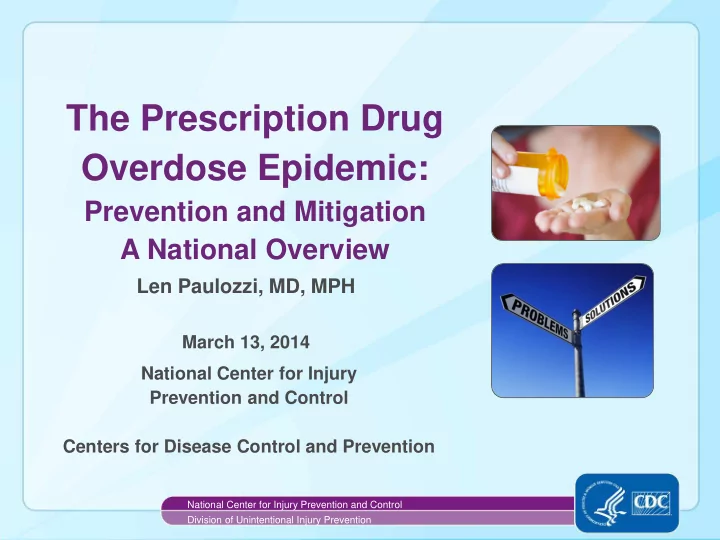

The Prescription Drug Overdose Epidemic: Prevention and Mitigation A National Overview Len Paulozzi, MD, MPH March 13, 2014 National Center for Injury Prevention and Control Centers for Disease Control and Prevention National Center for Injury Prevention and Control Division of Unintentional Injury Prevention
Drug overdoses have surpassed motor vehicle crashes as the leading cause of injury death Motor Vehicle Traffic Poisoning Drug Poisoning (Overdose) 25 Deaths per 100,000 population 20 15 10 5 0 1980 1982 1984 1986 1988 1990 1992 1994 1996 1998 2000 2002 2004 2006 2008 2010 Year 2
Death Rates for Drug Overdose by State, 2010 13.1 10.4 12.9 3.4 7.3 12.9 10.9 11.8 7.8 6.3 15.0 13.9 NH 11.8 8.6 15.3 6.7 VT 9.7 20.7 16.1 10.0 14.4 MA 11.0 16.9 28.9 RI 15.5 10.6 12.7 6.8 9.6 17.0 CT 10.1 23.6 NJ 9.8 11.4 DE 16.6 17.5 16.9 MD 11.0 19.4 23.8 14.6 12.5 DC 12.9 11.8 10.7 11.4 9.6 13.2 16.4 11.6 Age-adjusted rate per 100,000 population 10.9 3.4 - 10.9* 10.9* - 13.9 14.0 - 28.9 Footnote: *10.9 is in two ranges due to rounding. HI is 10.88 while WI is 10.94
Middle-aged adults are at greatest risk for drug overdose in the US 30 Death rates by age 45-54 25 Deaths per 100,000 population 35-44 20 25-34 55-64 15 10 15-24 5 65 & over 0 1999 2000 2001 2002 2003 2004 2005 2006 2007 2008 2009 2010 CDC/NCHS, National Vital Statistics System 4
Opioid overdoses have driven the surge in overdose deaths 35,000 16,651 opioid deaths in 2010 30,000 25,000 4,030 opioid deaths in 1999 20,000 15,000 10,000 5,000 0 1999 2000 2001 2002 2003 2004 2005 2006 2007 2008 2009 2010 National Vital Statistics System, 1999-2010 5
Opioid deaths, sales, and treatment admissions have increased in lockstep 8 Opioid Sales (kg per 10k) 7 6 Opioid Deaths (per 100k) 5 4 3 2 Opioid Treatment Admissions (per 10k) 1 0 1999 2000 2001 2002 2003 2004 2005 2006 2007 2008 2009 2010 National Vital Statistics System, DEA’s Automation of Reports and Consolidated Orders System, SAMHSA’s TEDS National Vital Statistics System, DEA’s Automation of Reports and Consolidated Orders System, SAMHSA’s TEDS 6
Opioid analgesic prescribing rates, United States, 2011
Opioid analgesics users in the past month Medical Nonmedical users users 4.9 million 9.0 million National Survey on Drug Use and Health, 2012. http://www.oas.samhsa.gov 8
Overdose deaths are the tip of the iceberg emergency department visits SAMHSA NSDUH, DAWN, TEDS data sets Coalition Against Insurance Fraud. Prescription for Peril. http://www.insurancefraud.org/downloads/drugDiversion.pdf 2007. 9
Economic costs are high $72.5 billion in healthcare costs 1 Opioid abusers generate, on average, annual direct health care costs 8.7 times higher than nonabusers 2 1. Coalition Against Insurance Fraud. Prescription for peril: how insurance fraud finances theft and abuse of addictive prescription drugs. Washington, DC: Coalition Against Insurance Fraud; 2007 2. White AG, Birnbaum, HG, Mareva MN, et al. Direct Costs of Opioid Abuse in an Insured Population in the United States. J Manag Care Pharm . 11(6):469-479. 2005 10
Risk Factors Demographics Socioeconomics and Geography • Men • Medicaid • 35-54 year olds • Rural • Whites Clinical Characteristics • American Indians/Alaska • Chronic pain Natives • Substance abuse • Mental health • Nonmedical use • Multiple prescriptions • Multiple prescribers • High daily dosage 11
CDC’s public health response: focus areas Inform Enhance Surveillance Policy Improve Empower Clinical States Practice 12
CDC’s approach to prescription drug overdose prevention Data driven and evidence-based Complements other agencies Focuses on empowering states to address 3 key drivers of the epidemic The link between increased, often inappropriate, prescribing of opioids and increased overdose deaths The small percentage of providers responsible for most of the inappropriate prescribing The small percentage of high-risk patients engaging in abuse and diversion going undetected by providers 13
Pivot to Prevention Prescription Drug Monitoring Programs (PDMPs) Patient Review & Restriction Programs Laws/Regulations/Policies Insurers & Pharmacy Benefit Managers (PBM) Clinical Guidelines 14
Prescription Drug Monitoring Programs (PDMPs) Status of PDMPS – September 2013 Source: Alliance of States with Prescription Monitoring Programs 15
Patient Review and Restriction Programs (aka “Lock-In” Programs) APPLICATION: Patients with inappropriate use of controlled substances STRATEGY: 1 prescriber and 1 pharmacy for controlled substances OUTCOME: Improve coordination of care and ensure appropriate access for patients at high risk for overdose IMPACT: Cost savings as well as reductions in ED visits and numbers of providers and pharmacies 16
Laws/Regulation/Policies STATE RESPONSE: Some states have enacted laws & policies aimed at reducing diversion, abuse & overdose KEY AIM: Strengthen health care provider accountability PATIENT PROTECTION: Safeguard access to treatment when implementing policies GAP: Rigorous evaluations to determine effectiveness and identify model components 17
Insurer/Pharmacy Benefit Manager (PBM) Mechanisms Reimbursement incentives/disincentives Formulary development Quantity limits Step therapies/Prior Authorization Real-time claims analysis Retrospective claims review programs 18
Clinical Guidelines Improve prescribing and treatment Basis for standard of accepted medical practice for purposes of licensure board actions Several consensus guidelines available Common themes among guidelines 19
Conclusions BURDEN: Overdose deaths from prescription drugs have reached epidemic levels in the United States KEY DRIVERS: Defining the drivers of the epidemic are critical to effective solutions SCOPE OF SOLUTION: Multifaceted approach is needed. Recent successes promising KNOWN EFFECTIVENESS: Interventions must be evaluated to determine effectiveness and need for state-specific adaptation 20
Thank You Len Paulozzi lbp4@cdc.gov The findings and conclusions in this report are those of the author and do not necessarily represent the views of the Centers for Disease Control and Prevention. National Center for Injury Prevention and Control Division of Unintentional Injury Prevention
Recommend
More recommend